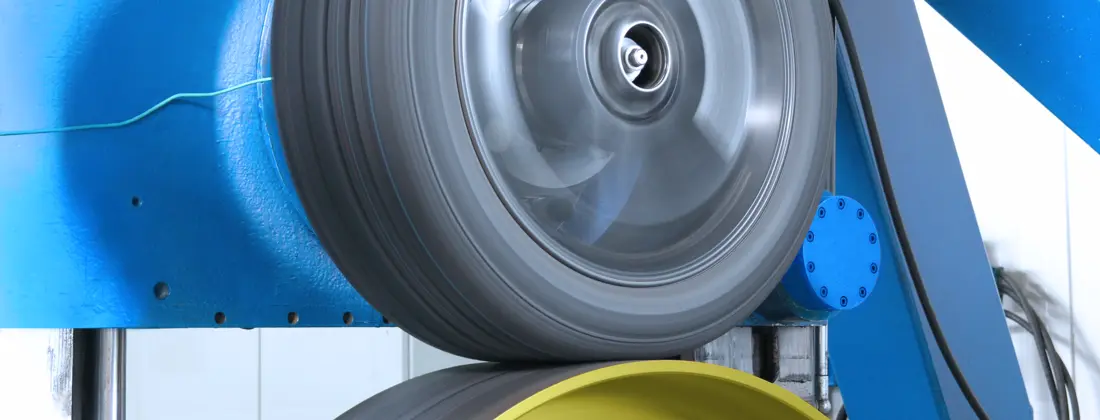ASTM F408 Skid Resistance Tyre Testing
In the automotive industry, tyre performance is critical to safety and efficiency. One of the most important parameters that determine a tyre’s performance is its skid resistance. ASTM F408 provides a standardized method for measuring the coefficient of friction between tyres and road surfaces under controlled conditions. This test not only ensures compliance with international standards but also aids in product development, quality control, and safety assessments.
The ASTM F408 procedure involves a dynamic skid test where a tyre is subjected to a sliding motion on a wet pavement surface. The friction coefficient is measured using an instrumented vehicle that simulates real-world driving conditions. This service ensures that tyres meet the highest standards of performance and safety, which is essential for both consumer products and commercial vehicles.
The test protocol outlined in ASTM F408 is designed to be robust and repeatable. It provides a quantitative measure of tyre skid resistance, which can then be used to compare different tyre models or evaluate the effectiveness of new product designs. The results are crucial for quality managers to make informed decisions regarding production processes and material selection.
For R&D engineers, ASTM F408 offers a valuable tool to optimize tyre design and improve overall performance. By understanding how tyres behave under controlled wet-surface conditions, engineers can identify areas for improvement in traction, durability, and fuel efficiency. The test also helps procurement teams source materials that meet stringent quality criteria.
Compliance officers, on the other hand, rely on ASTM F408 to ensure that their tyre products are up-to-date with the latest regulatory requirements. This service ensures that tyres not only perform well but also adhere to international standards like ISO and EN. By leveraging this standardized testing method, companies can minimize risks associated with non-compliance.
Applied Standards
- ASTM F408 Standard Practice for Testing the Coefficient of Friction Between Tires and Wet Pavement Surfaces Using an Instrumented Vehicle
- ISO 15376, Road Vehicles - Determination of Skid Resistance with a Tire-Brake Tester on a Test Section
- EN 14801, Tyres for use on Road Vehicles - Determination of Wet Skid Resistance by Instrumented Vehicle Test
The ASTM F408 procedure is widely recognized and used across the automotive industry. It complements other international standards such as ISO 15376 and EN 14801, which provide additional methods for measuring wet skid resistance. The combination of these standards ensures a comprehensive approach to tyre testing.
By adhering to these standards, companies can demonstrate their commitment to quality and safety, thereby enhancing consumer confidence in the products they produce. Compliance with such standards is not only beneficial for regulatory purposes but also aids in building trust among customers and stakeholders.
Scope and Methodology
| Test Parameter | Description | Methodology |
|---|---|---|
| Tyre Type | Includes passenger cars, light trucks, and commercial vehicles. | The test is conducted on a specific tyre model under controlled conditions. |
| Test Surface | A wet pavement surface simulating real-world driving conditions. | The surface is prepared to ensure it meets the specified moisture content and temperature. |
| Instrumented Vehicle | An instrumented vehicle that simulates a typical passenger car or truck. | The vehicle is equipped with sensors to measure the coefficient of friction accurately. |
| Test Speed | The vehicle travels at a specified speed, typically 60 km/h. | The speed is carefully controlled and monitored during the test. |
| Data Collection | The coefficient of friction is recorded as the vehicle skids on the wet surface. | Data is collected using sophisticated software to ensure accuracy and precision. |
The ASTM F408 test involves a controlled dynamic skid test where the tyre is subjected to sliding motion under specific conditions. The friction coefficient is measured using an instrumented vehicle that simulates real-world driving scenarios. This ensures that the results are both reliable and representative of actual road conditions.
Industry Applications
- Quality Control: Ensuring tyres meet strict performance standards before they reach the market.
- R&D Optimization: Identifying areas for improvement in tyre design and material selection.
- Compliance Assurance: Meeting regulatory requirements and ensuring product safety.
- Customer Satisfaction: Providing tyres that offer superior performance and longevity.
The ASTM F408 skid resistance test is particularly valuable for quality control departments. By using this standardized method, companies can ensure that each batch of tyres meets the required standards before they are shipped to retailers or distributors. This helps in maintaining a consistent level of performance across all products.
For R&D engineers, ASTM F408 offers an invaluable tool for optimizing tyre design and improving overall performance. By understanding how tyres behave under controlled wet-surface conditions, engineers can identify areas for improvement in traction, durability, and fuel efficiency. This knowledge is crucial for developing next-generation tyres that offer superior performance and safety.
Compliance officers rely on ASTM F408 to ensure that their tyre products are up-to-date with the latest regulatory requirements. By adhering to this standardised testing method, companies can minimize risks associated with non-compliance. This is particularly important in regions where strict regulations govern tyre performance.
Finally, customer satisfaction is a key consideration for any tyre manufacturer. By providing tyres that offer superior performance and longevity, manufacturers can build trust among customers and stakeholders. The ASTM F408 test ensures that the tyres they produce meet the highest standards of quality and safety.





